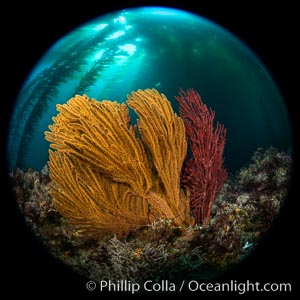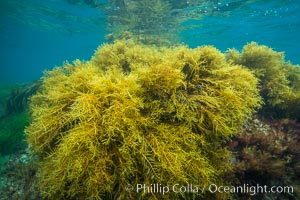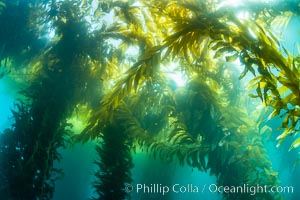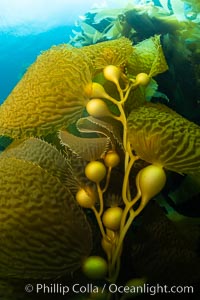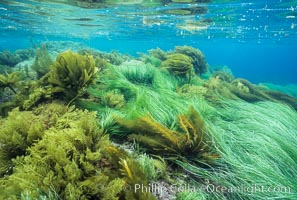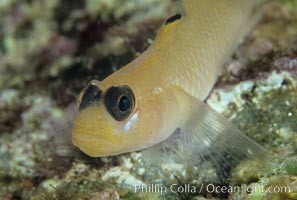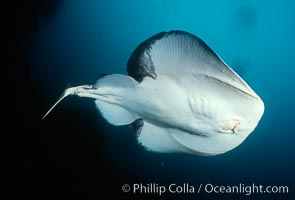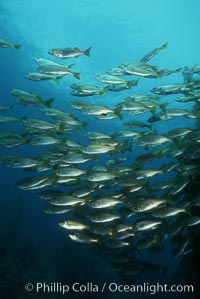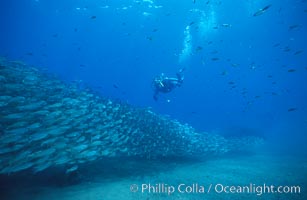
California reef covered with purple hydrocoral (Stylaster californicus, Allopora californica), Farnsworth Banks.

Pacific torpedo ray Tetronarce californica, amidst huge schools of fish and baitfish, Farnsworth Banks, Catalina Island. This electric ray will shock the hell out of you if you are not careful.
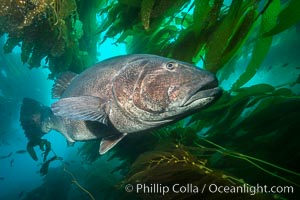
Giant black sea bass, endangered species, reaching up to 8' in length and 500 lbs, amid giant kelp forest.

Sunlight streams through giant kelp forest. Giant kelp, the fastest growing plant on Earth, reaches from the rocky reef to the ocean's surface like a submarine forest.

Garibaldi and golden gorgonian, with a underwater forest of giant kelp rising in the background, underwater.
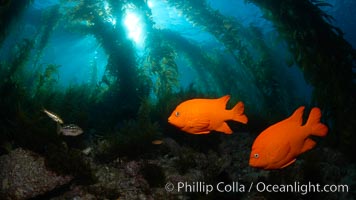
Garibaldi swims in the kelp forest, sunlight filters through towering giant kelp plants rising from the ocean bottom to the surface, underwater.
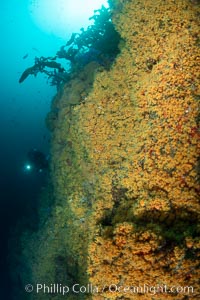
The rare yellow zoanthid anemone Epizoanthus giveni, in large aggregations on the Yellow Wall at Farnsworth Banks, Catalina Island.

Red gorgonian Leptogorgia chilensis, purple hydrocoral Stylaster californicus, and yellow zoanthid anemone Epizoanthus giveni, at Farnsworth Banks, Catalina Island.

Sunlight streams through giant kelp forest. Giant kelp, the fastest growing plant on Earth, reaches from the rocky reef to the ocean's surface like a submarine forest.

Sunlight streams through giant kelp forest. Giant kelp, the fastest growing plant on Earth, reaches from the rocky reef to the ocean's surface like a submarine forest.

Garibaldi and Brown Gorgonian Muricea fruticosa, Catalina Island, with giant kelp stands reaching from the reef to the surface of the ocean in the distance. The clown prince of the kelp forest, the Garibaldi, alternately poses for me and chirps at me to move away from his gorgonian.

Pyrosome drifting through a kelp forest, Catalina Island. Pyrosomes are free-floating colonial tunicates that usually live in the upper layers of the open ocean in warm seas. Pyrosomes are cylindrical or cone-shaped colonies made up of hundreds to thousands of individuals, known as zooids.

Gorgonian (yellow) that has been parasitized by zoanthid anemone (Savalia lucifica), and red gorgonian (Lophogorgia chilensis), Farnsworth Banks, Catalina Island.

Red gorgonian Leptogorgia chilensis. The lower sea fan has its polyps retracted while the upper sea fan has all of its polyps extended into the current. Farnsworth Banks, Catalina Island, California.

Kelp fronds and pneumatocysts. Pneumatocysts, gas-filled bladders, float the kelp off the ocean bottom toward the surface and sunlight, where the leaf-like blades and stipes of the kelp plant grow fastest. Catalina Island, California.

Garibaldi maintains a patch of algae (just in front of the fish) to entice a female to lay a clutch of eggs.
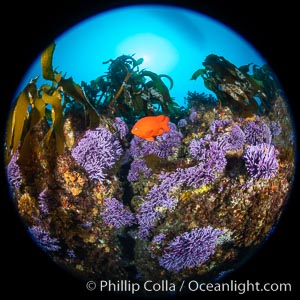
California reef covered with purple hydrocoral (Stylaster californicus, Allopora californica) and palm kelp, with orange garibaldi fish whizzing by, Catalina Island.

Red gorgonian (Lophogorgia chilensis) on Farnsworth Banks reef. Farnsworth Banks holds some of the most lush and colorful reefs to be found in California.
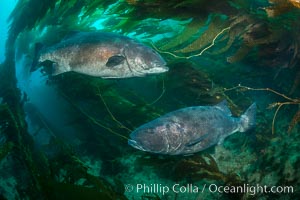
Two giant black sea bass swim in a courtship circle, part of a larger gathering of a mating aggregation amid kelp forest, Catalina Island. In summer months, black seabass gather in kelp forests in California to form mating aggregations. Courtship behaviors include circling of pairs of giant sea bass, production of booming sounds by presumed males, and nudging of females by males in what is though to be an effort to encourage spawning.
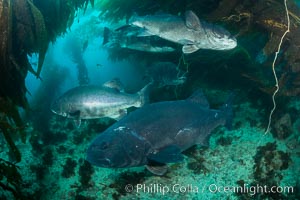
Five giant black sea bass in a mating and courtship aggregation in the kelp forest at Catalina Island. In summer months, black seabass gather in kelp forests in California to form mating aggregations leading to spawning. Courtship behaviors include circling of pairs of giant sea bass, production of booming sounds by presumed males, and nudging of females by males in what is though to be an effort to encourage spawning.

Red gorgonian Leptogorgia chilensis, purple hydrocoral Stylaster californicus, and yellow zoanthid anemone Epizoanthus giveni, at Farnsworth Banks, Catalina Island.

Red gorgonian (Lophogorgia chilensis) rises above fields of purple hydrocoral (Stylaster californicus, Allopora californica) on Farnsworth Bank, Catalina Island.

Giant black sea bass, endangered species, reaching up to 8' in length and 500 lbs, amid giant kelp forest.

Garibaldi and golden gorgonian, with a underwater forest of giant kelp rising in the background, underwater.
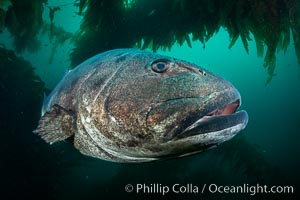
Giant black sea bass, endangered species, reaching up to 8' in length and 500 lbs, amid giant kelp forest. Catalina Island, California, USA.









